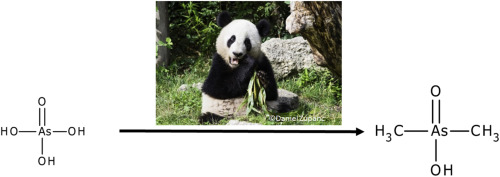当前位置:
X-MOL 学术
›
Chemosphere
›
论文详情
Our official English website, www.x-mol.net, welcomes your
feedback! (Note: you will need to create a separate account there.)
Unusual arsenic metabolism in Giant Pandas
Chemosphere ( IF 8.1 ) Pub Date : 2017-09-18 , DOI: 10.1016/j.chemosphere.2017.09.073 Simone Braeuer , Eveline Dungl , Wiebke Hoffmann , Desheng Li , Chengdong Wang , Hemin Zhang , Walter Goessler
Chemosphere ( IF 8.1 ) Pub Date : 2017-09-18 , DOI: 10.1016/j.chemosphere.2017.09.073 Simone Braeuer , Eveline Dungl , Wiebke Hoffmann , Desheng Li , Chengdong Wang , Hemin Zhang , Walter Goessler

|
The total arsenic concentration and the arsenic speciation in urine and feces samples of the two Giant Pandas living at Vienna zoo and of their feed, bamboo, were determined with ICPMS and HPLC-ICPMS. Urine was the main excretion route and accounted for around 90% of the ingested arsenic. The urinary arsenic concentrations were very high, with up to 179 μg/L. Dimethylarsinic acid (DMA) was the dominating arsenic compound in the urine samples and ranged from 73 to 92% of the total arsenic, which is unusually high for a terrestrial mammal. The feces samples contained around 70% inorganic arsenic and 30% DMA. The arsenic concentrations in the bamboo samples were between 16 and 920 μg/kg dry mass. The main arsenic species in the bamboo extracts was inorganic arsenic. This indicates that the Giant Panda possesses a unique way of very efficiently methylating and excreting the provided inorganic arsenic. This could be essential for the survival of the animal in its natural habitat, because parts of this area are contaminated with arsenic.
中文翻译:

大熊猫中异常的砷代谢
使用ICPMS和HPLC-ICPMS测定了生活在维也纳动物园的两只大熊猫及其饲料竹的尿液和粪便样品中总砷浓度和砷形态。尿是主要的排泄途径,约占摄入砷的90%。尿砷浓度非常高,高达179μg/ L。二甲基亚砷酸(DMA)是尿液样品中的主要砷化合物,占总砷的73%至92%,对于陆生哺乳动物而言,这是异常高的。粪便样品中约含70%的无机砷和30%的DMA。竹样品中的砷浓度在16至920μg/ kg干质量之间。竹提取物中的主要砷种类是无机砷。这表明大熊猫拥有一种独特的方式,可以非常有效地甲基化和排泄所提供的无机砷。这对于动物在其自然栖息地中的生存可能至关重要,因为该区域的部分区域被砷污染。
更新日期:2017-09-18
中文翻译:

大熊猫中异常的砷代谢
使用ICPMS和HPLC-ICPMS测定了生活在维也纳动物园的两只大熊猫及其饲料竹的尿液和粪便样品中总砷浓度和砷形态。尿是主要的排泄途径,约占摄入砷的90%。尿砷浓度非常高,高达179μg/ L。二甲基亚砷酸(DMA)是尿液样品中的主要砷化合物,占总砷的73%至92%,对于陆生哺乳动物而言,这是异常高的。粪便样品中约含70%的无机砷和30%的DMA。竹样品中的砷浓度在16至920μg/ kg干质量之间。竹提取物中的主要砷种类是无机砷。这表明大熊猫拥有一种独特的方式,可以非常有效地甲基化和排泄所提供的无机砷。这对于动物在其自然栖息地中的生存可能至关重要,因为该区域的部分区域被砷污染。











































 京公网安备 11010802027423号
京公网安备 11010802027423号